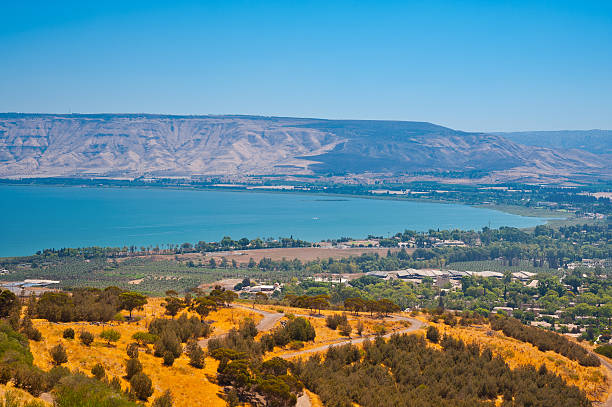The Sea of Galilee, also Kinneret, Lake of Gennesaret or Lake Tiberias, is a freshwater lake in Israel. It is about 53 km in circumference, about 21 km long and 13 km wide. Its area is 166.7 km2 (64.4 square miles) in its fullest, and its maximum depth is approximately 43 m (141 feet). Between 215 meters (705 ft) and 209 meters (686 ft) below sea level, it is the world’s lowest freshwater lake and the second-lowest lake in the world (after the Dead Sea, a saltwater lake). The lake is partly fed by underground springs, although its main source is the Jordan, which flows from north to south.
The Sea of Galilee is located on the ancient Via Maris, which connected Egypt with the northern empires. The Greeks, Hasmoneans, and Romans founded thriving cities and settlements on the lake, including hippos and Tiberias. The first-century historian Flavius Josephus was so impressed by the area he wrote: “One can call this place the ambition of nature”; He also reported a thriving fish industry at the time, with 230 boats working regularly on the lake. Archaeologists discovered in 1986 such a boat nicknamed “Jesus Boat”.
Much of Jesus’ ministry took place on the banks of the Galilee Lake. At that time there was a continuous band development of settlements and villages around the lake and abundant trade and boat crossings. The synoptic Gospels of Mark 1: 14-20, Matthew 4: 18-22, and Luke 5: 1-11 describe how Jesus recruited four of his apostles from the shores of the Galilee Lake: the fishermen Simon and his brother Andrew and the brothers John and James. One of Jesus’ famous educational episodes, the Sermon on the Mount, is said to have taken place on a hill above the lake. Many of his miracles are said to have happened here as well, including his walk on the water, which soothes the storm, the disciples, and the wonderful fishing, and his feeding of five thousand people (in Tabgha). In the Gospel of John, the sea offers students the opportunity to see Jesus after his resurrection (John 21).
In 135 AD, the rebellion of Bar Kokhba was crushed. The Romans responded by banning all Jews from Jerusalem. The center of Jewish culture and learning shifted to the Galilee and Kinneret region, especially to the city of Tiberias. In this region, the Jerusalem Talmud was put together.


Comment (0)